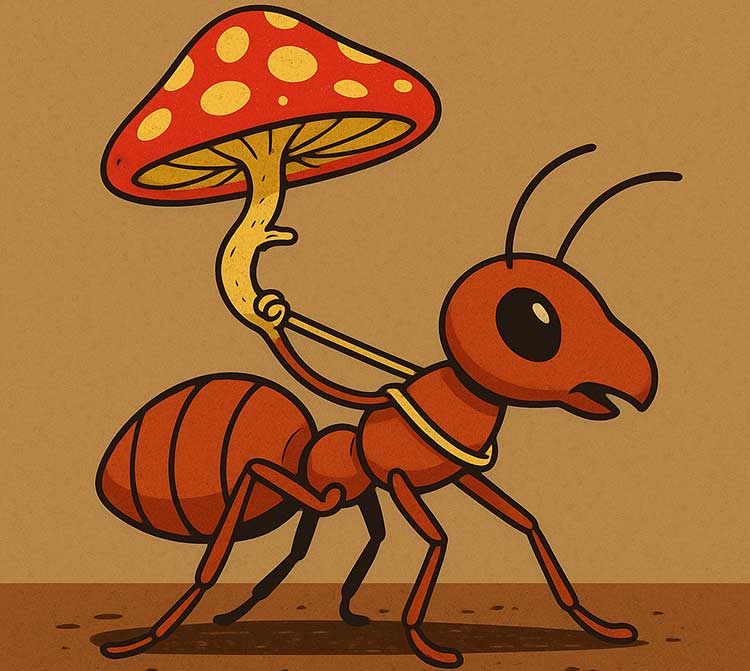Win Prizes at our Future Leaders Debate Championship! Click here!

What we're talking about!
Check back often for updates!
Exploring nature’s strangest and spookiest stories
Zombies — we’ve seen them everywhere. In movies, they stagger with outstretched arms and blank stares, feasting on brains and spreading their infection with a single bite. In video games and books, they’re the perfect mix of scary and thrilling. But here’s the spooky question that actually has a scientific twist: can zombies be real?
Before you roll your eyes and chalk it up to fiction, let’s look a little closer at what science tells us. While Hollywood zombies aren’t real (thankfully), the natural world is full of organisms that do something eerily similar: they hijack the bodies and brains of other creatures, turning them into mindless, obedient hosts. Yes — real zombie-like behavior exists in nature. And it’s just as creepy as you imagine.
The Zombie-Ant Fungus
Let’s begin in the humid rainforests of South America, where an innocent-looking fungus named Ophiocordyceps unilateralis preys on ants. This fungus doesn’t just infect ants — it controls their behavior.
Here’s how it works: the fungus’s spores land on an ant and slowly begin to grow inside its body. Once the fungus takes hold, it changes the ant’s behavior. The ant leaves its colony, climbs up a tree or plant, and bites down hard on a leaf or twig. This is no accident — the fungus has “reprogrammed” the ant to position itself in the perfect spot for the next stage.
Then, the fungus kills the ant. A long stalk-like structure bursts from the ant’s head, releasing new spores to the forest floor below. The whole process starts again, infecting more ants.
It’s a real-life horror story: a parasite that turns its host into a puppet, just long enough to make sure it can spread. Scientists call it “parasitic manipulation,” and it’s one of the most fascinating and terrifying phenomena in biology.
Snails with Pulsing Eyeballs
As weird as zombie ants are, they’re not alone. In damp environments around the world, another mind-controlling parasite is at work: Leucochloridium paradoxum, a flatworm that invades snails.
This parasite’s goal is to reach birds, where it can reproduce. But snails aren’t exactly on every bird’s menu — unless they’re made to look delicious. So the flatworm crawls into the snail’s eye stalks, turning them green, fat, and pulsing like juicy caterpillars. The snail becomes more visible and tempting to birds, who then eat it. Once inside the bird, the parasite completes its life cycle and lays its eggs.
From the snail’s point of view, this is a nightmare. From the parasite’s point of view, it’s perfect planning.
Rodents That Lose Their Fear
Parasites don’t just affect bugs and snails. In fact, there’s one microscopic parasite that can affect mammals — even humans.
Toxoplasma gondii is a single-celled parasite that lives in cats but uses rodents to get there. When a rodent is infected, Toxoplasma alters its brain chemistry. The result? The rodent actually loses its fear of cats — and sometimes becomes attracted to the smell of cat urine. Yes, really.
The rodent is now much more likely to get eaten, and Toxoplasma ends up right where it wants to be: inside a cat. While the parasite doesn’t “control” the rodent like a remote-control toy, it changes behavior just enough to serve its own goals.
Interestingly, Toxoplasma gondii can also infect humans — most often through undercooked meat or exposure to cat litter. While it doesn’t turn people into zombies, some studies suggest it may slightly affect human behavior or risk-taking tendencies. The research is ongoing, but the idea that a parasite can influence mammal behavior is no longer science fiction.
What Does This All Mean?
So — are zombies real?
If you’re thinking of the classic human-undead kind from horror movies, then no, we’re safe (for now). But if we define a “zombie” as a living creature whose thoughts and behaviors are controlled by another organism, then the answer is a spooky yes.
Nature is full of examples where parasites manipulate hosts for their own survival, sometimes in ways that look straight out of a horror film. Scientists are still studying these interactions to understand how they evolved and what they can tell us about the brain, behavior, and even neuroscience.
These stories and facts are perfect for read-together times. While these facts can be eerie, these stories can spark curiosity and open up conversations that lead to meaningful learning. It's a perfect mix of scary and smart. Kids (and adults!) are naturally curious about things that are a little gross, a little creepy, and totally real. Lessons about parasitic mind control can lead into topics like:
It’s a great reminder that science isn’t just lab coats and formulas — it’s full of mystery, weirdness, and wonder.
The next time you watch a zombie movie or dress up for Halloween, remember that something even stranger than fiction might be lurking in the soil, in the forest, or even in your backyard garden.
Because when it comes to nature’s real-life zombies, the truth is scarier — and far more fascinating — than fiction.
Ready to unleash your child's inner innovator? Explore our programs and discover how PopSmart Academy can help your child reach their full potential. Your child can achieve great things with the right support and guidance. Book a FREE trial class here.
Help your kids fall in love with reading!
Need a list of amazing books to get your kids inspired about writing their own stories?
Grab your free copy by completing the form.
We'll email you the ebook!